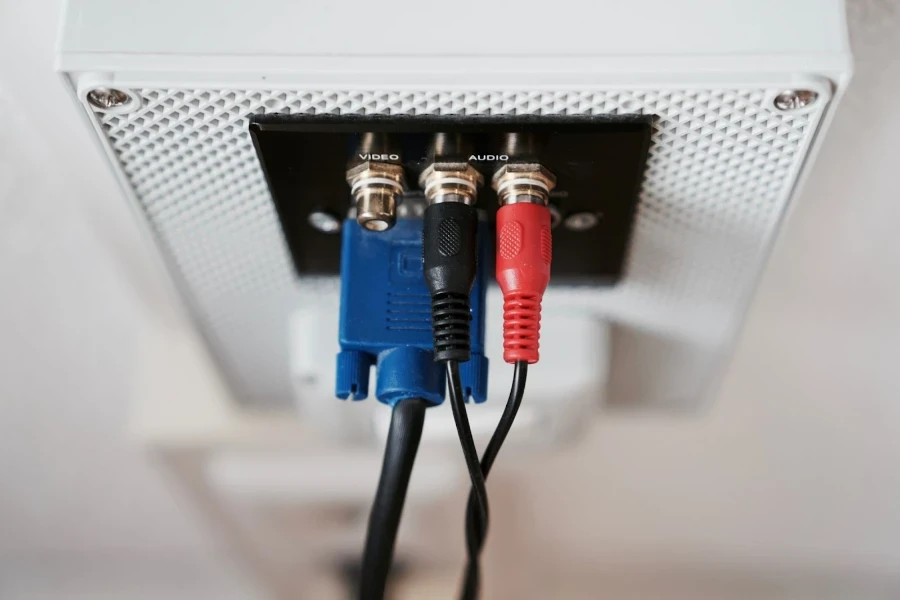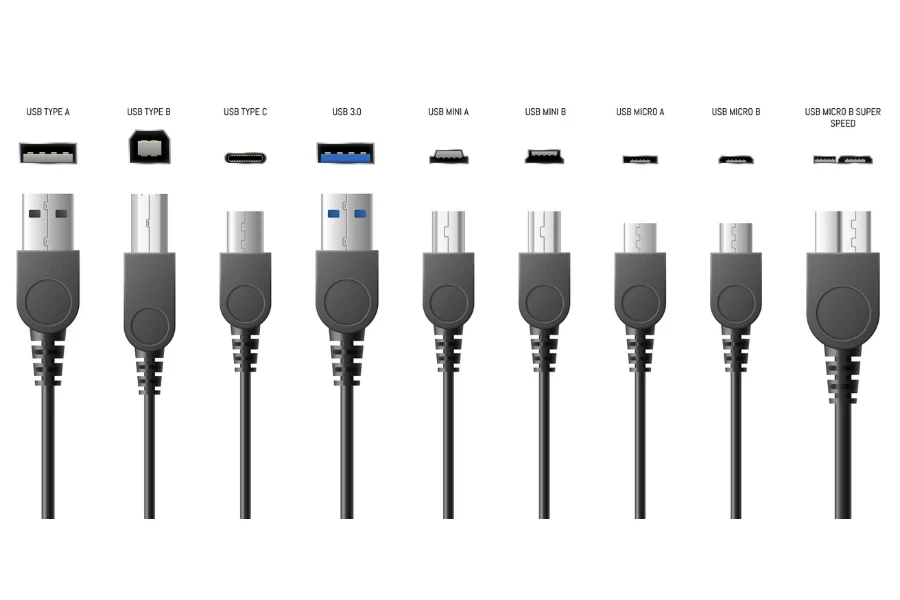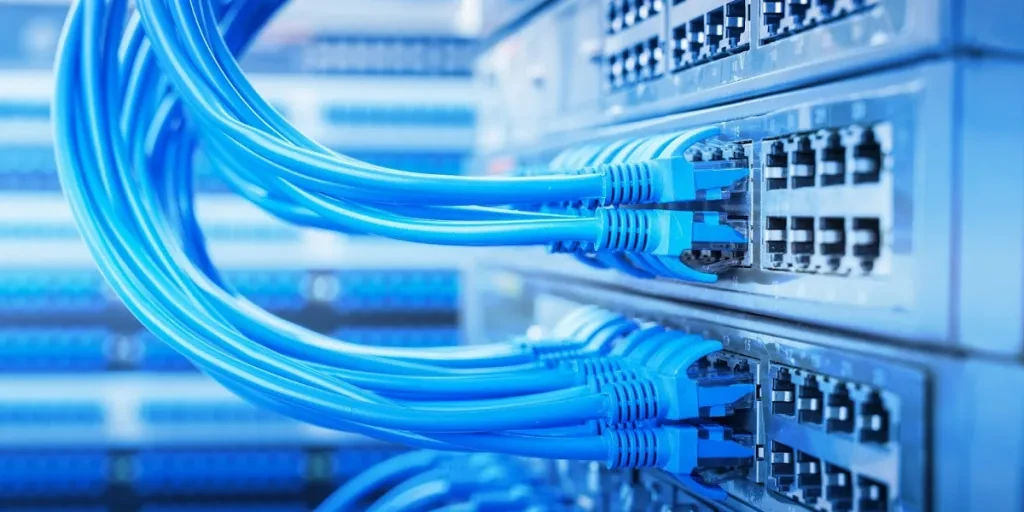The world of data cables is vast and varied, with each type designed to cater to specific needs and environments. Let’s delve deeper into the intricacies of these cables, understanding their structure, design, and predominant uses.
Table of Contents
Diving into data cables: Types and characteristics
The power of proper networking: Cable options for retailers
USB evolution: Understanding connector types for retail needs
Future-proofing your retail connectivity
Diving into data cables: Types and characteristics
Twisted Pair: The Telecommunication Titan
Twisted pair cables, often seen as the backbone of many communication systems, consist of one or more pairs of electrical wires arranged in a spiral. This design is not just for aesthetics; the twisting helps reduce interference and enhances signal quality. There are two primary types of twisted pairs:
Comprising color-coded copper wires, unshielded twisted pair (UTP) lacks any foil or braiding as insulation against interference. Despite this, it’s known for its versatility, being used in both analog and digital data transmission. Its ease of implementation, cost-effectiveness, and high performance over short distances make it a favorite among many industries, especially telecommunications and computer networks.
As the name suggests, shielded twisted pair (STP) cables come with an additional layer of protection in the form of a foil or braided mesh. This shielding, which needs to be grounded, prevents electromagnetic noise penetration and eliminates cross-talk, ensuring a clearer and more stable signal.
Coaxial cable: Beyond TV and telephone

Coaxial cables have been a staple in the world of data transmission for years. Comprising a central conductor enveloped by an insulator, these cables can transmit signals at higher frequencies than their twisted pair counterparts. Their primary domain has been digital telephone networks and TV communication. The design ensures that the inner conductor is protected from external interference, making it a reliable choice for long-distance data transmission.
Fibre optic: Speed of light connectivity

In the realm of high-speed internet and vast data transmission, fibre optic cables reign supreme. These cables don’t rely on traditional electrical signals. Instead, they transmit data via light channels, ensuring minimal signal degradation over long distances. The core and cladding structure of these cables allows for the transmission of light particles encoded with data. Their resistance to signal degradation, combined with their high-speed and bandwidth capabilities, makes them an ideal choice for environments that demand rapid and vast data transfers.
Understanding the nuances of these cables is crucial for online retailers. The right choice can ensure seamless operations, while the wrong one can lead to disruptions and potential losses. As the digital landscape continues to evolve, staying informed about these foundational elements becomes not just beneficial but essential.
The power of proper networking: Cable options for retailers
In the fast-paced world of online retail, the foundation of any successful operation lies in its infrastructure. The right networking cables can make the difference between a seamless transaction and a lost sale. Let’s explore some of the top choices for retailers aiming for optimal connectivity.
Cat5e: Cost-effective connectivity
Cat5e, standing for Category 5 enhanced, has become a standard in many networking environments. Offering speeds of up to 1 Gbps for distances up to 100 meters, it’s a cost-effective solution for businesses that require reliable connectivity without breaking the bank. While it might not be the newest kid on the block, Cat5e has proven its worth in various settings, from small offices to expansive retail spaces. Its ability to deliver consistent performance, especially in environments where ultra-high-speed isn’t a necessity, makes it a go-to choice for many retailers, according to 777networks.co.uk.
Cat6 & Cat6a: The future-proof choices
When it comes to future-proofing your network, Cat6 and Cat6a cables stand out. These cables are designed with thicker cores, allowing for enhanced data transmission. While both can comfortably support 1 Gbps speeds over 100 meters, Cat6 shines in shorter distances. For lengths up to 55 meters, Cat6 can achieve impressive speeds of up to 10 Gbps. This makes it a prime choice for businesses that foresee a surge in data transfer needs in the near future. The added advantage? Cat6 cables come with better shielding, ensuring reduced interference and a more stable connection, as highlighted by matrix-ndi.com.
Fibre optic in networking
For retailers operating over vast distances or in areas prone to high electromagnetic interference, fibre optic cables are a game-changer. Unlike traditional cables that rely on electrical signals, fibre optics use light to transmit data. This not only allows for faster data transmission but also ensures minimal signal loss over long distances. Ideal scenarios for its deployment include large retail chains with centralized data centers or businesses located in densely populated urban areas. The benefits? High-speed data transfer, resistance to interference, and a future-ready infrastructure, as emphasized by 777networks.co.uk.
For online retailers, understanding the nuances of these cables is more than just technical knowledge. It’s about ensuring that every transaction, every customer interaction, and every business operation runs smoothly. Making the right choice today can pave the way for a more connected and efficient tomorrow.
USB evolution: Understanding connector types for retail needs
In the digital age, the Universal Serial Bus (USB) has become an integral part of our daily lives, especially in the retail sector. Its evolution has been nothing short of revolutionary.

USB Type A to C: The evolutionary path
The journey began with the USB-A, the most familiar and widely used USB connector, which dominated computer equipment and peripherals. But as technology advanced, the need for a more versatile and efficient connector arose. Enter USB Type-C. This smaller, reversible, oval-shaped connector is poised to become the universal standard for both commercial and industrial computers. Its design eliminates the age-old problem of plugging in a USB the wrong way, making it a game-changer in the world of connectivity. According to newnex.com, the evolution from standard connections to the versatile USB Type C has been significant in shaping the future of USB technology.
Mini & Micro USB: The compact connectors
Before the rise of USB Type-C, Mini and Micro USB connectors held the fort. These compact connectors were prevalent in a myriad of electronics, from tablets and handheld GPS devices to cell phones. However, as technology evolved, these connectors saw a decline, being gradually replaced by newer, more efficient types. The transition, as highlighted by newnex.com, signifies the relentless pursuit of innovation in the USB domain.
USB 3.0 & beyond: SuperSpeed and internal connectors
The world of USB didn’t just stop at connectors. The data transfer rates have seen exponential growth. From the humble beginnings of USB 1.0 with a maximum transfer rate of 12 Mbps, we now have USB 3.2 Gen 2×2 offering a whopping 20 Gbps and USB4 boasting 40 Gbps. The most recent USB4 Version 2.0, as per newnex.com, promises speeds of up to 80 Gbps. These advancements ensure faster data transfers and specialized connectors for diverse needs, emphasizing the importance of staying updated in the retail sector.
Future-proofing your retail connectivity
In the ever-evolving landscape of digital retail, staying updated with the latest in cable technologies isn’t just a recommendation; it’s a necessity. The right cables ensure seamless operations, enhancing the customer experience manifold. From the humble beginnings of USB-A to the revolutionary USB4 Version 2.0, the journey of USB technology underscores the importance of adaptation. For online retailers, this means ensuring that their systems are equipped with the latest connectors and cables, ready to meet the demands of the future. After all, in the world of online retail, customer satisfaction hinges not just on the products you sell but also on the technology that powers your operations.




